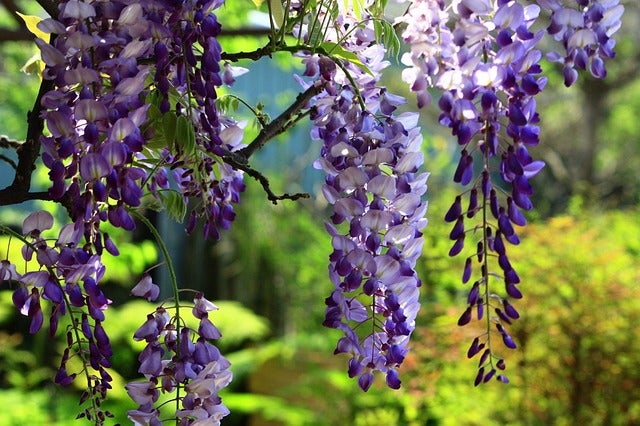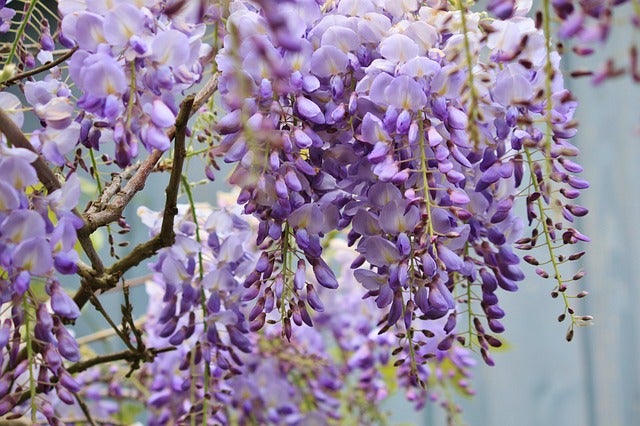General information
Wisteria is one of the most popular and spectacular of all flowering garden plants and adds stunning effect to any garden or landscape. It produces magnificent hanging grape-like clusters (racemes) of fragrant blue-violet flowers in the late spring and provides quite a show. Wisteria flowers make any garden enchanting and exotic looking. Wisteria belongs to the Pea family, Fabaceae (formerly Leguminoseae). The genus includes ten species of deciduous climbing vines, two native to the southern United States and the others native to eastern Asia. The Wisteria plant is colorful, versatile, fast growing, long lived and easy to care for. It can be grown as a vine, a tree or a shrub. The Wisteria plant has a vigorous, twining habit and needs plenty of room and a very strong structure to climb on. It can be grown on a gateway, wood pergola, arbor or trellis. Wisteria can grow up to 40 -75 feet. Wisteria plants require full sun, good drainage and reliable moisture during flowering and the initial growth period. It does need seasonal pruning to ensure spring blooms and compact growing.

Wisteria produces spectacular cascading flowers which bloom over a period of 4 to 5 weeks in the spring, and permeate the landscape with a heady perfume. Flowers may appear within 4 years after planting but can take as long as 15 years. The flowers are pendulous clusters of delicate scented petals that hang from the Wisteria plant like bunches of grapes. Each Wisteria flower is pea like and very fragrant. Wisteria flowers come in violet, purple, bluish-purple, pink, blue and white. Two species of Wisteria are typically grown in home gardens:
- Wisteria Floribunda (the Japanese one)
- Wisteria Sinensis (the Chinese one)
Japanese Wisteria has large 12 to 18 inch clusters of flowers. It usually flowers as the leaves are developing. Japanese Wisteria flowers come in white, pink, blue and violet and are very fragrant. Chinese Wisteria flowers before the leaves appear. Chinese Wisteria produces 6 to 9 inch clusters of flowers, which are white, violet, lilac-blue, blue and have a mild sweet fragrance. Chinese Wisteria tends to bloom within four years after planting. The main difference between Japanese and Chinese Wisteria is that Japanese Wisteria twines clockwise around the host plant and the Chinese Wisteria twines counter-clockwise around the host plant. Also, Japanese Wisteria flowers are more fragrant and more prominent than the Chinese Wisteria flowers.
Description

Wisteria is a woody and high-climbing vine. It has a twining growth habit and develops into a stunning beautiful specimen 40-75 feet in height. It has a long life span relative to most other plant species, and fast growth rate. The Wisteria plant has shiny, bright green compound leaves which fall in the autumn. Its leaves are divided into many pointed-oval leaflets and there are usually 9 to 13 green leaflets per stem. In the spring, around March or April, the Wisteria plant produces an amazing quantity of beautiful scented cascading flower clusters resembling bunches of grapes. The flowers increase in size and beauty with each year. Wisteria flowers occur in long (1-3 feet in length), pendulous racemes and open sequentially from the base to the tip. Individual Wisteria flowers are nearly 1 inch long and are white, pink, violet-blue or lavender and quite fragrant. The flowers are sometimes followed by decorative 3- to 6-inch-long, velvety green seed pods, which contain 3-6 glossy disk-like violet purple seeds each about 0.5 inch across. The Wisteria plant pods turn brown as they dry and often persist into winter. Attention: The Wisteria plant seeds are poisonous and should be kept away from children and pets.
Care
Wisteria is, without a doubt, one of the most impressive flower plants. It is easy to grow and pest-and disease free. The Wisteria plant needs little care and a strong support to climb on and hold the weight. It can be grown as a vine on a house wall or on a sturdy arbor or pergola. It can also be planted on a porch or patio roof to create an outdoor room like feel with a ceiling of Wisteria flowers above your head. The Wisteria plant also can be grown as a tree or a shrub, in which case you will need to implement some sort of frame support. The Wisteria Tree is hardy, thriving in zones 4-9. It requires a deep, moderately fertile, moist soil that does not dry out excessively. It is very important to keep the soil moist during the initial growth period, the flower period and the drought period. The Wisteria plant performs best in full sun. It can grow in a shady area, but it will not produce Wisteria flowers. The Wisteria plant does not require fertilization. Wisteria must be properly pruned to promote blooming and control growth and size. The key to Wisteria pruning is to prune it at least once a year. Ideally, you should prune it twice a year-once in the summertime after the Wisteria flowers have gone and then again in early winter. In the summertime, cut all the whippy growths back to two or three buds of the main stem from which they are growing, in early winter cut back all the whippy growths to four buds of the branch from which they are growing. Also, do not forget to cut out all dead or damaged wood and crowded branches.
Chinese Wisteria
Chinese Wisteria (Wisteria Sinensis) is a vigorous, fast growing, long-lived, twining ornamental with fragrant and colorful Wisteria flowers. Chinese Wisteria, also known as Common Wisteria or Sweet Wisteria, is native to China. It was first introduced into the United States in 1816 for ornamental purposes. Chinese Wisteria grows to 40-75 feet tall and twins in a counter-clockwise motion around any available support. Stems are smooth and gray in color and can attain diameters of up to 15 inches. Leaves are shiny, green, compound and consist of 7 to 13 leaflets to about 2 to 4 inches in length. In late May, Chinese Wisteria forms huge, pendulous, grape like clusters of white, violet, lilac-blue, blue Wisteria flowers. Chinese Wisteria produces flowers before the leaves emerge. All the Wisteria flowers of one raceme open simultaneously and they have an appealing fragrance. Each Chinese Wisteria flower is 1/2 to 1 inch long. The flowers are followed by attractive velvety pods 4-6 inches in length containing 4-6 seeds. Chinese Wisteria can be grown as a container specimen, bonsai or a small tree. It is hardy in USDA hardiness zones 5-9. Chinese Wisteria requires full sun to partial shade. It tolerates a variety of soil and moisture regimes, but prefers well-drained, loamy soil. Supports must be sturdy, because the mature plants are very heavy and can easily overwhelm nearby structures and plants. The weight from Wisteria can topple the trees. Chinese Wisteria can also kill trees by choking and shading them. Annual pruning is necessary, Chinese Wisteria easily escapes landscape plantings and spreads aggressively into natural areas.
Sign up for the Gardening Know How newsletter today and receive a free copy of our e-book "How to Grow Delicious Tomatoes".